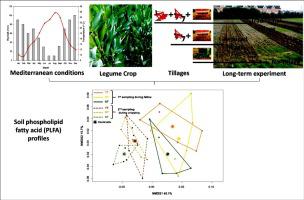当前位置:
X-MOL 学术
›
Agric. Ecosyst. Environ.
›
论文详情
Our official English website, www.x-mol.net, welcomes your
feedback! (Note: you will need to create a separate account there.)
Long-term impacts of conservation tillage on Mediterranean agricultural soils: shifts in microbial communities despite limited effects on chemical properties
Agriculture, Ecosystems & Environment ( IF 6.0 ) Pub Date : 2020-12-01 , DOI: 10.1016/j.agee.2020.107144 Marco Panettieri , Laura L. de Sosa , María T. Domínguez , Engracia Madejón
Agriculture, Ecosystems & Environment ( IF 6.0 ) Pub Date : 2020-12-01 , DOI: 10.1016/j.agee.2020.107144 Marco Panettieri , Laura L. de Sosa , María T. Domínguez , Engracia Madejón

|
Abstract Mediterranean ecosystems are especially sensitive to the effects of intensive agriculture. Therefore, sustainable practices based on the protection of organic matter and water in soil are of great interest in these systems. Among these practices, tillage and crop rotation could induce changes in soil properties and consequently on soil microbial communities, which play a fundamental role in soil fertility. In this work we evaluated the changes in some soil chemical and biochemical properties induced by different tillage types -non-tillage (NT), reduced tillage (RT) and traditional tillage (TT)- in a trial that was established 10 years ago in a typical Mediterranean crop rotation. Phospholipid fatty acid analysis (PLFA) was performed to test the effect of tillage on the structure of the soil microbial community. Two soil samplings were performed, one after tillage operation (fallow period) and the other during the late stage of a legume crop to compare the effects of long-term tillage and crop development in these variables. Results indicated that conservation tillages (NT and RT) had positive effects on soil chemical properties (mainly on soil N) in comparison to TT, especially during the fallow period. Crop production, however, was similar between treatments. Some biochemical (enzyme activities) and biological (PLFA profile) parameters were better indicators of the effect of tillage type on soil than chemical variables. PLFA profiles were more different among tillage types during the fallow period, but when PLFAs were assigned into functional groups the tillage effect was more evident after crop development, when conservation tillage (NT and RT) promoted a higher abundance of soil fungi over bacteria. We strongly recommend that PLFA analysis should be performed on fallow period before tillage operations, and to couple PLFA measurement with at least one method of microbial activity in order to fully assess the impact of different tillage systems on soil functioning. The results have allowed, to 1) quantify the effect of tillage on the distribution of bacterial and fungal communities in the soil (PLFA) and on its functionality (enzyme activities) during the development of a legume crop and 2) establish that the combined use of chemical and biological variables is necessary to set up indicators of soil quality in tillage comparison trials.
中文翻译:

保护性耕作对地中海农业土壤的长期影响:尽管对化学性质的影响有限,但微生物群落的变化
摘要 地中海生态系统对集约化农业的影响特别敏感。因此,基于保护土壤中有机物质和水的可持续实践对这些系统具有重要意义。在这些实践中,耕作和轮作可以引起土壤性质的变化,从而引起土壤微生物群落的变化,这在土壤肥力中起着根本性的作用。在这项工作中,我们评估了不同耕作类型 - 免耕 (NT)、减耕 (RT) 和传统耕作 (TT) - 在 10 年前建立的一项试验中引起的一些土壤化学和生化特性的变化。典型的地中海作物轮作。进行磷脂脂肪酸分析 (PLFA) 以测试耕作对土壤微生物群落结构的影响。进行了两次土壤取样,一次在耕作操作后(休耕期),另一次在豆类作物的后期进行,以比较长期耕作和作物发育对这些变量的影响。结果表明,与 TT 相比,保护性耕作(NT 和 RT)对土壤化学性质(主要是土壤 N)具有积极影响,尤其是在休耕期。然而,处理之间的作物产量相似。一些生化(酶活性)和生物(PLFA 剖面)参数是比化学变量更好地指示耕作类型对土壤影响的指标。休耕期间不同耕作类型的PLFA谱差异较大,但当PLFAs被分配到功能组时,作物发育后耕作效果更加明显,当保护性耕作(NT 和 RT)促进土壤真菌的丰度高于细菌时。我们强烈建议在耕作之前的休耕期进行 PLFA 分析,并将 PLFA 测量与至少一种微生物活动方法结合起来,以充分评估不同耕作系统对土壤功能的影响。结果允许 1) 量化耕作对土壤中细菌和真菌群落 (PLFA) 分布的影响及其在豆类作物发育过程中的功能(酶活性),以及 2) 确定联合使用在耕作比较试验中,必须使用化学和生物变量来建立土壤质量指标。我们强烈建议在耕作之前的休耕期进行 PLFA 分析,并将 PLFA 测量与至少一种微生物活动方法结合起来,以充分评估不同耕作系统对土壤功能的影响。结果允许 1) 量化耕作对土壤中细菌和真菌群落 (PLFA) 分布的影响及其在豆类作物发育过程中的功能(酶活性),以及 2) 确定联合使用在耕作比较试验中,必须使用化学和生物变量来建立土壤质量指标。我们强烈建议在耕作之前的休耕期进行 PLFA 分析,并将 PLFA 测量与至少一种微生物活动方法结合起来,以充分评估不同耕作系统对土壤功能的影响。结果允许 1) 量化耕作对土壤中细菌和真菌群落 (PLFA) 分布的影响及其在豆类作物发育过程中的功能(酶活性),以及 2) 确定联合使用在耕作比较试验中,必须使用化学和生物变量来建立土壤质量指标。
更新日期:2020-12-01
中文翻译:

保护性耕作对地中海农业土壤的长期影响:尽管对化学性质的影响有限,但微生物群落的变化
摘要 地中海生态系统对集约化农业的影响特别敏感。因此,基于保护土壤中有机物质和水的可持续实践对这些系统具有重要意义。在这些实践中,耕作和轮作可以引起土壤性质的变化,从而引起土壤微生物群落的变化,这在土壤肥力中起着根本性的作用。在这项工作中,我们评估了不同耕作类型 - 免耕 (NT)、减耕 (RT) 和传统耕作 (TT) - 在 10 年前建立的一项试验中引起的一些土壤化学和生化特性的变化。典型的地中海作物轮作。进行磷脂脂肪酸分析 (PLFA) 以测试耕作对土壤微生物群落结构的影响。进行了两次土壤取样,一次在耕作操作后(休耕期),另一次在豆类作物的后期进行,以比较长期耕作和作物发育对这些变量的影响。结果表明,与 TT 相比,保护性耕作(NT 和 RT)对土壤化学性质(主要是土壤 N)具有积极影响,尤其是在休耕期。然而,处理之间的作物产量相似。一些生化(酶活性)和生物(PLFA 剖面)参数是比化学变量更好地指示耕作类型对土壤影响的指标。休耕期间不同耕作类型的PLFA谱差异较大,但当PLFAs被分配到功能组时,作物发育后耕作效果更加明显,当保护性耕作(NT 和 RT)促进土壤真菌的丰度高于细菌时。我们强烈建议在耕作之前的休耕期进行 PLFA 分析,并将 PLFA 测量与至少一种微生物活动方法结合起来,以充分评估不同耕作系统对土壤功能的影响。结果允许 1) 量化耕作对土壤中细菌和真菌群落 (PLFA) 分布的影响及其在豆类作物发育过程中的功能(酶活性),以及 2) 确定联合使用在耕作比较试验中,必须使用化学和生物变量来建立土壤质量指标。我们强烈建议在耕作之前的休耕期进行 PLFA 分析,并将 PLFA 测量与至少一种微生物活动方法结合起来,以充分评估不同耕作系统对土壤功能的影响。结果允许 1) 量化耕作对土壤中细菌和真菌群落 (PLFA) 分布的影响及其在豆类作物发育过程中的功能(酶活性),以及 2) 确定联合使用在耕作比较试验中,必须使用化学和生物变量来建立土壤质量指标。我们强烈建议在耕作之前的休耕期进行 PLFA 分析,并将 PLFA 测量与至少一种微生物活动方法结合起来,以充分评估不同耕作系统对土壤功能的影响。结果允许 1) 量化耕作对土壤中细菌和真菌群落 (PLFA) 分布的影响及其在豆类作物发育过程中的功能(酶活性),以及 2) 确定联合使用在耕作比较试验中,必须使用化学和生物变量来建立土壤质量指标。











































 京公网安备 11010802027423号
京公网安备 11010802027423号